Week 10 Overheads
Research Questions
- What do the birds remember?
- How are the memories used to retrieve cached food?
Issues
- Animal cognition consists of specialized and general purpose mechanisms.
- Specialized cognitive mechanisms are adaptations to specific slection pressures.
- The brain is responsive to selection for cognitive abilities.
Black-capped chickadees
Store thousands of food pieces over the winter
Do not reuse cache sites
Recover most of the food on the same day it is cached (some cached much longer)
Black-capped chickadee experiments
(Sherry, 1997)
Octagonal cage surrounded by landmarks with feed site
Maintaining landmark formation, rotate them
- Birds orient by landmarks to find feed site
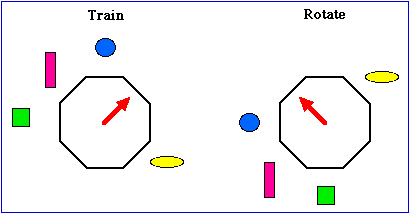
Randomize landmark formation
- Birds ignore landmarks and use unknown cues to find feed site
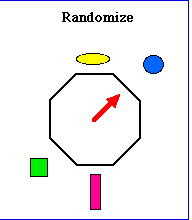
Sun-compass and landmarks in black-capped chickadees
(Sherry, 1997)
Use outdoor cache cage
Birds on 6 hr phase delay
- Sun compass off by 90 deg
Birds actually shift 45 deg
Compromise between sun compass and landmarks
Hippocampus
(Sherry, Jacobs, and Gaulin, 1992)
Avian hippocampus (HP) on dorsal surface of brain
Avian and mammalian HP different, but true homologues
Lesioning black-capped chickadee HP eliminates cache recovery ability
- Lesioned birds keep caching and searching, but search in wrong places
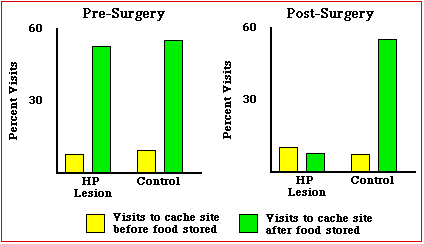
Hippocampal Differences between Food Storing/Non-storing Birds
(Sherry, Vaccarino, Buckenham, and Herz, 1989)
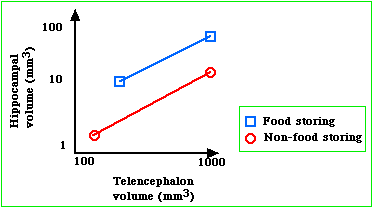
Food storing birds have bigger HP
Brown Headed Cowbirds (BHC)
(Sherry, Forbes, Khurgel, and Ivy, 1993)
Brood parasites
- Lay eggs in other birds nests
Related to red winged blackbirds (RWB) and grackles (G)
- Neither RWB or G are brood parasites
Female BHC lay ~40 eggs/year
Spend morning searching for host nest
- Lay egg next morning when host bird goes to feed
Female BHC store 10-20 possible nests sites for next day
Male BHCs do not do this sort of search
Collected male and female BHCs, RWBs, and Gs
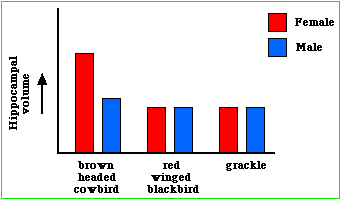
Female BHC have bigger HP than male BHC
Non-brood parasites, no sex difference
Three Species of Cowbirds
M. bonariensis (broad range parasite)
- Big sex difference for HP
M. rufoaxilaris (specialized parasite)
- No sex difference for HP
- Both females and males search for host nests
M. badius (non-parasite)
Hippocamal Differences in Chickadees
No sex differences
- Both females and males cache
Sex difference in hippocampus not coincidental
Specific selective pressure that produced the differences
White Breasted Nuthatch
Cache more in winter than spring
Cache recover success rate about same across year
Hippocampal volume bigger in winter than spring
Species Differences in Spatial Memory
(Kamil, Balda, Olson, and Good, 1994)
Pinyon jays, nutcrackers, scrub jays
Pinyon & nutcrackers: 10,000s seeds in 1,000s sites. Scrub jays: 1,000s seeds in 100s sites
Test: pick new sites only after retention interval
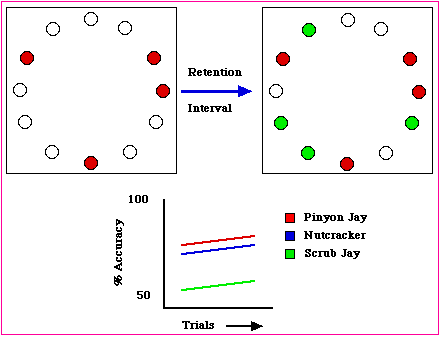
Environmental pressures on spatial memory performance
Fixing Landmarks in Memory
Chickadees do "turn-back-and-look"
- Poke seed into bark, wipe beak, turn head back and forth, fly off
If chickadees do not cache item themselves, they do not remember the site
Cant watch another bird cache item and retrieve it
Aging and Spatial Processing
(Linder and Schallert, 1988)
Spatial processing believed to decrease with age
- Lesion neocortex or hippocampus impairs Morris maze in rats
Cholinergic neurons
- Needed to learn new spatial information
- Cholinergic disfunction in older animals...impaired memory (especially spatial) performance
- Block cholinergic neuron function
- Use atropine sulfate
- Impairs Morris maze performance
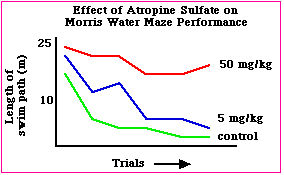
Interactive effect
- Cholinergic, shifting between strategies, decreased attention, etc.
Posterior Parietal Cortex
(Foreman, Save, Tinus-Blanc, and Buhot, 1992)
Posterior Parietal Cortex (PPC) damage in humans
- Visuospatial deficits on visual localization tasks
- Orientation difficulties
- Object positioning in egocentric framework
- Visual neglect contralateral to lesion
- Preferential search in field ipsolateral to lesion
PPC associated with superior colliculous (SC): involved in attetion
7 rats bilateral PPC, 7 rats ipsilateral PPC, 6 controls
Protocol
- Light at RGD on, rat presses door, gets milk, then a NGD lighted. If lighted NGD pressed, another reward. For 70 trials.
- Distractor trials: one or both DLs flash.
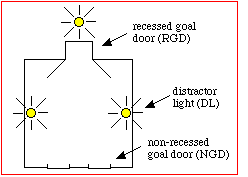
Bilateral PPC lesions: less direct routes
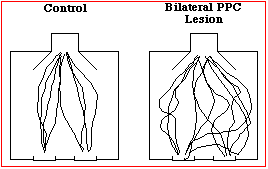
Unilateral PPCs did not affect route
- Need only one intact side
When DL on, unilateral PPC turn ipsilateral to intact side
Parietal Cortex & Hippocampus
(
Save, Poucet, Foreman, and Buhot, 1992)
Distinguish hippocampus (HP) from parietal cortex (PC)
14 HP, 15 APC, 14 PPC, 17 CT
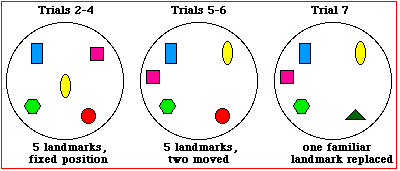
Results: locomotory speed, landmarks touched
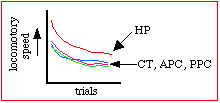
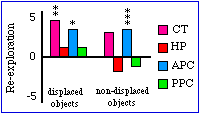
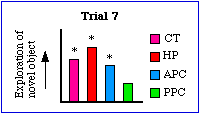
HP not reacting to spatial changes is consistent with other studies
PPC relevant to spatial representational memories
APC detect geometric changes, but dont acquire new spatial information (attentional processes impaired)
HP crucial in "cognitive map", but not for simple associative tasks
Egocentric and Geocentric Representations
(
Save and Moghaddam, 1996)
Morris water maze
- Dark condition: egocentric (path integration)
- Light condition: geocentric
Bilateral Posterior parietal cortex (PPC) lesioned rats and sham controls (CT)
8 trials/day; 24 days dark, then 6 days light
Dark: PPC show greater escape latency than CT and slower swimming speed
Light: PPC show greater escape latency than CT and more misdirected movement
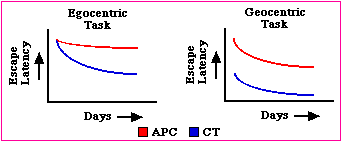
Conclusions
- Bilateral PPC adversely affects acquisition of navigation tasks from kinesthetic information
- PPC probably involved in converting egocentric to geocentric representation
Return to 403 course page.














